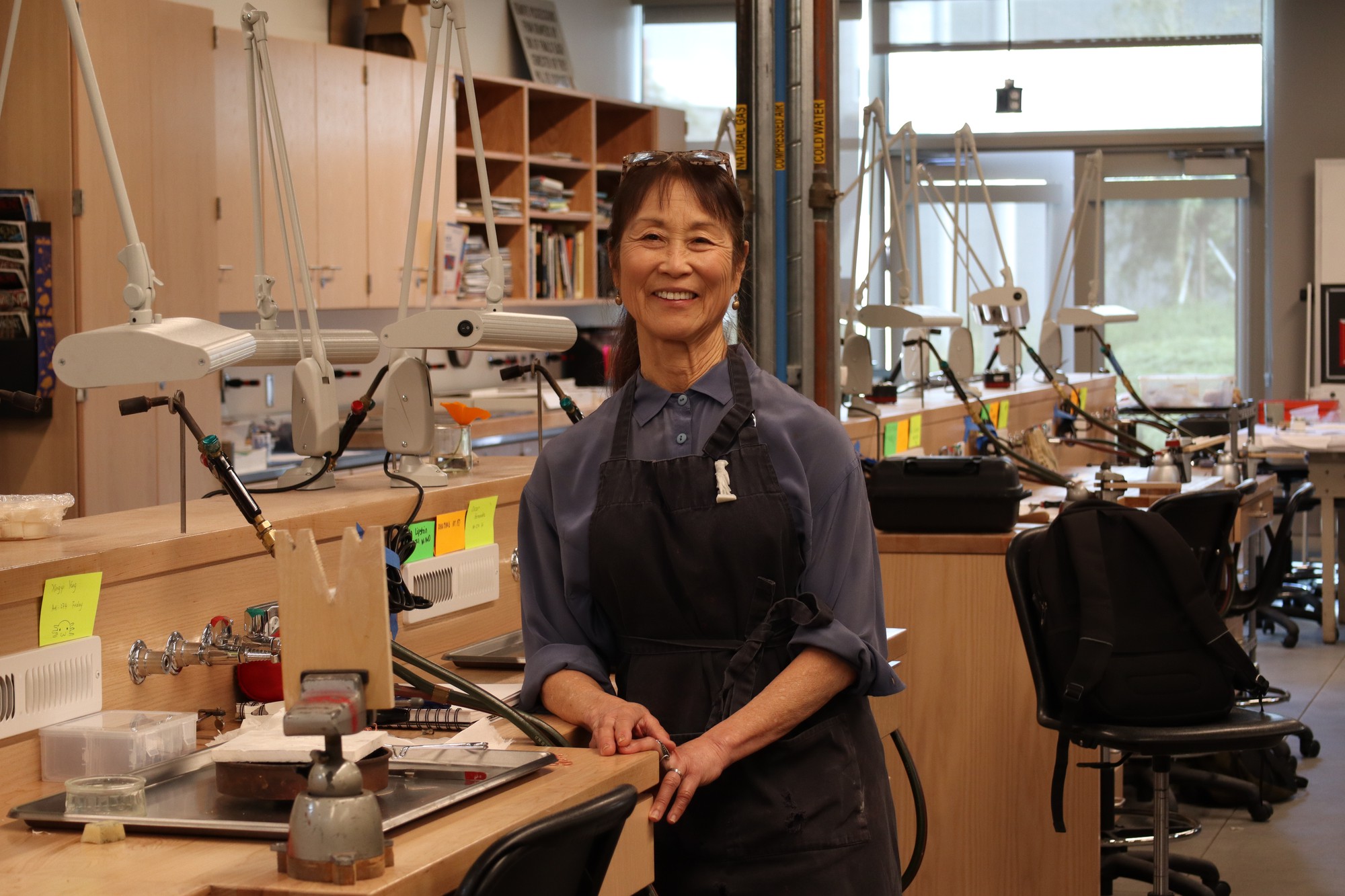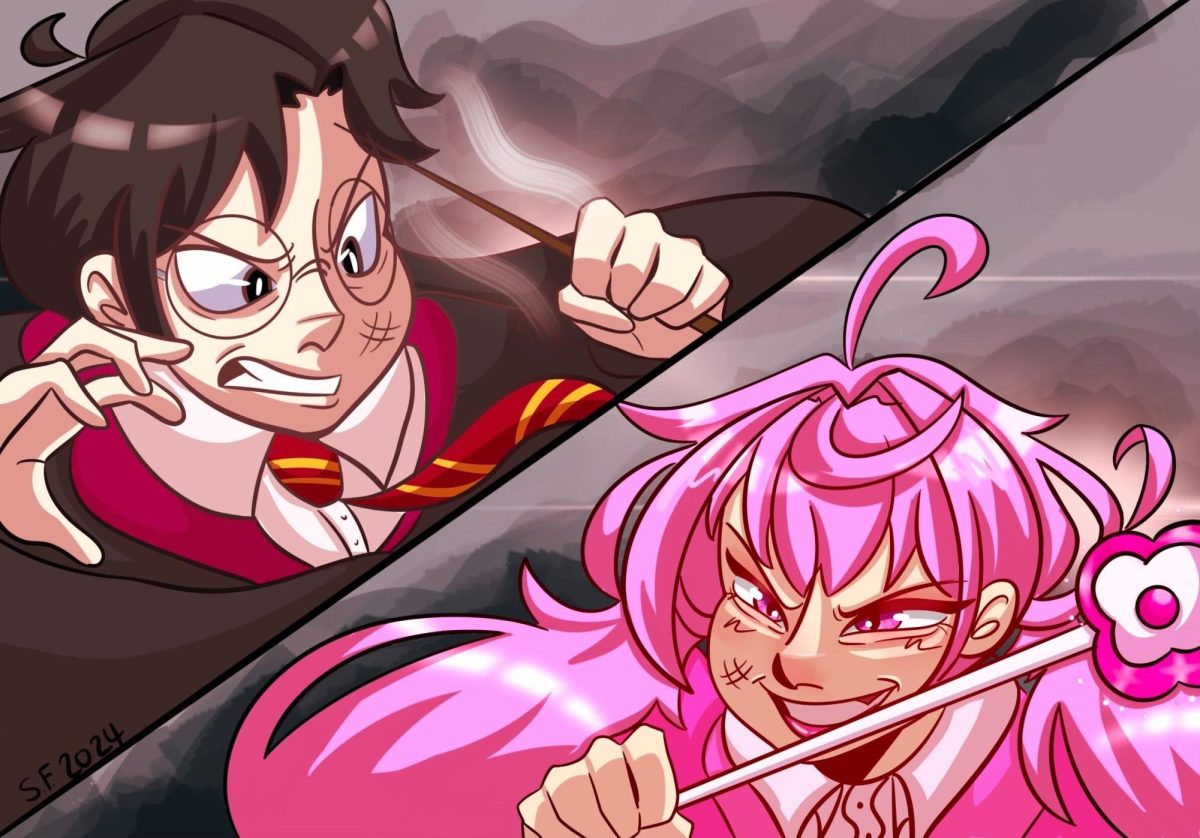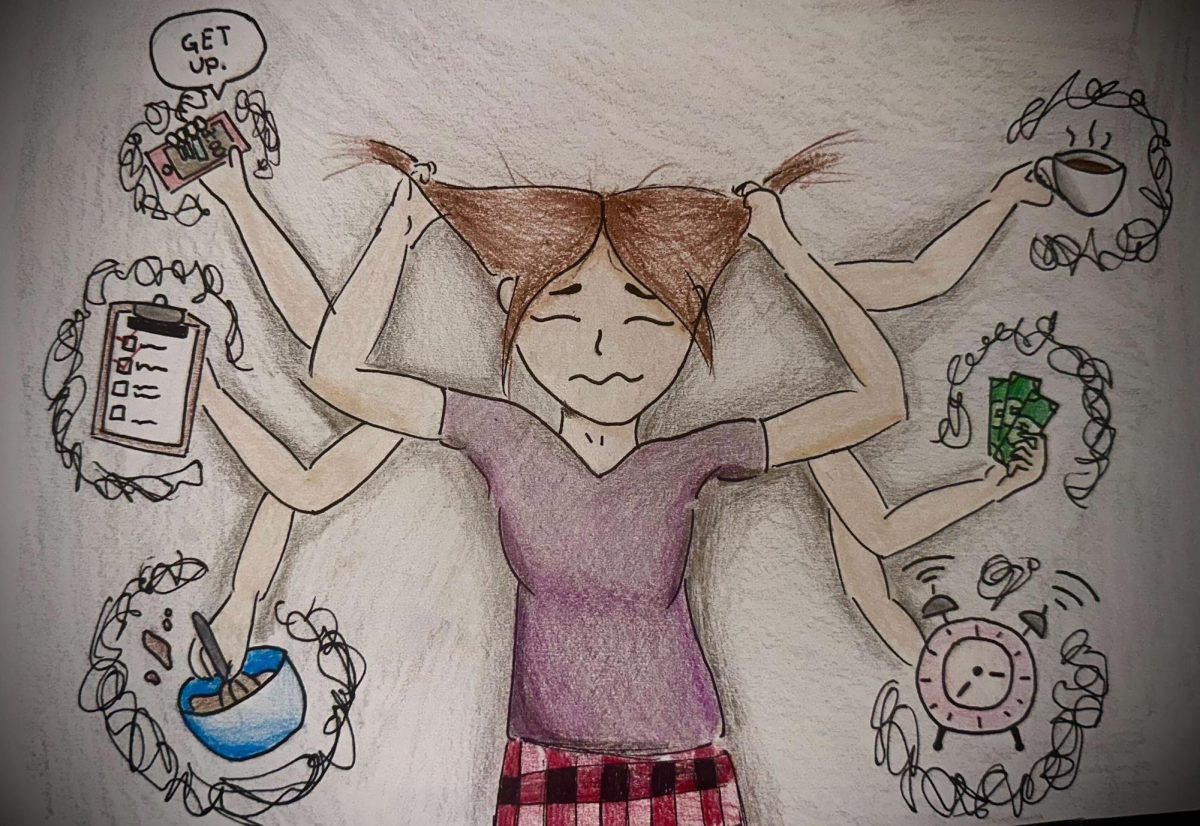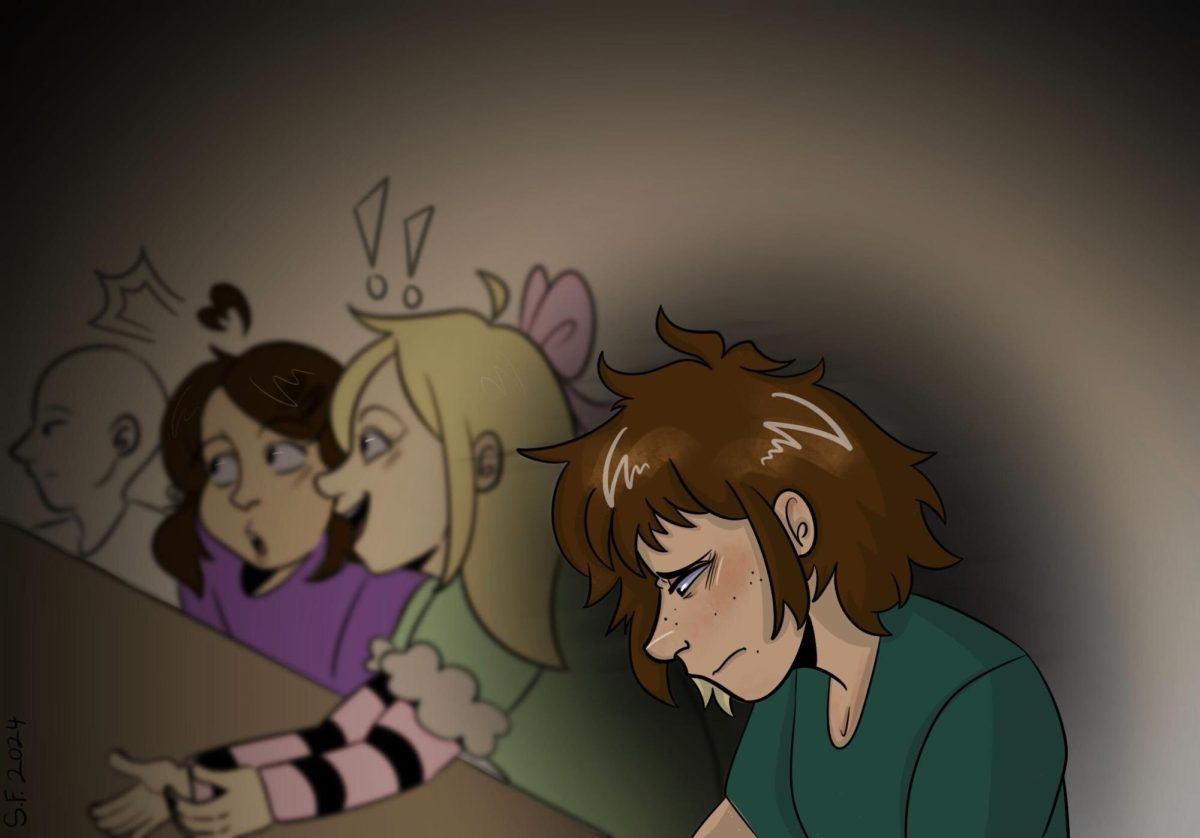Walk past the open door of Jewelry Studio 131 on a Friday afternoon, when the campus is nearly empty and one could pick up on the flurry of activity inside.
Inside, over a dozen students stand in a semi-circle. Each one clutches an empty saw frame, intently watching their instructor for the next step.
At the front of the room, professor Irene Mori delicately threads the needle-like blade into her saw frame and tightens it into place. Her crystal clear voice and quick, purposeful hand movements carry years of experience.
On her careful guidance, Mori’s beginner jewelry design students slowly, carefully mimic her movements as they put together their tools.
To make sure they have matched her instructions, Mori has them test the blades.
Not by sending them back to their workbenches with orders to saw pieces of aluminum into two. But by plucking at the blades.
What follows next is a chorus of gentle twangs that ring off each other.
“It’s like angels’ harps,” Mori said, smiling before moving on to their assignment: how to make a jump ring.
Since 1985, Mori has taught jewelry fabrication, design and metalsmithing at El Camino College. In that time, she has seen the program through a pandemic that saw students learning remotely and a move to a new arts facility.
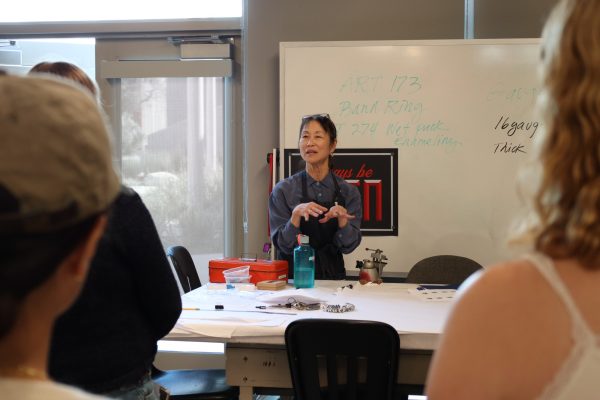
But there was a time where Mori didn’t even consider a career in the arts.
Growing up in a Japanese-American family in Los Angeles and attending classes at the Japanese Institute of Sawtelle, where her grandmother was a principal, art didn’t play a big role in her life.
“I guess in a lot of ways, looking back, it was a little bit more Japanese-American,” Mori said. “But, you know, what was really wonderful about how I grew up was that there was a great sense of community and I think I truly benefited from that.”
While studying mathematics at San Diego State University in the early 1970s, Mori enrolled in a jewelry making class to meet a course requirement.
“I didn’t know what I wanted to do,” Mori said. “I needed 12 units, as a lot of people these days do as well. And I needed to have a class that fit my schedule. So I looked at the schedule and I saw this class called jewelry that looked really interesting.”
As it turned out, the class was taught by legendary artist and jewelry maker Arline Fisch.
Fisch, who taught from 1961 until she retired as professor emerita of art in 2000, founded the jewelry and metalsmithing program at San Diego State University. She pioneered the use of weaving, knitting and crochet metal wire into elaborate collars and headpieces. Her work has been exhibited in galleries in the United States and abroad.
The moment Mori knew she wanted to make jewelry for a living didn’t come with the slight, sharp click of revelation under Fisch’s mentorship.
It came with the raspy drags of a jeweler’s needle file.
As she sat hunched over a workbench, meticulously filing away at the sharp edge of a brass piece, Mori marveled at how the brass changed under her careful pulls of the file. What was once a piece of raw material soon morphed into a smooth, shiny decorative piece.
“I thought, ‘oh, this is really cool,” Mori said, looking back on that day. “Like wow, this is really great. And I want to pursue this.”
Taking Fisch’s class opened up the world in a way Mori never could have imagined as a girl learning the Japanese language and customs in Sawtelle.
It also forged a friendship that has endured over the decades.
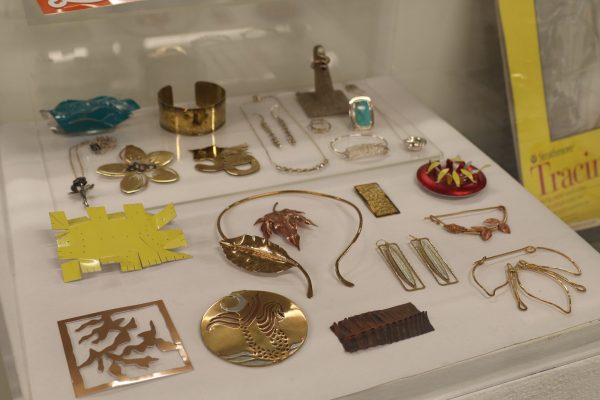
“I’m still in touch with [Fisch] and we celebrated her 92nd birthday,” Mori said.
After graduating from San Diego State with a bachelor’s in fine arts and from Cal State Long Beach with an MFA in jewelry design and metalsmithing, Mori spent the rest of the 1970s and part of the 1980s holding down a variety of jobs. These included selling designs to manufacturers in downtown L.A. and teaching at colleges across Los Angeles county.
“I was a true freeway flier,” Mori said.
An average day as an adjunct instructor would find her zipping up and down the vast Southern California freeway system, from campus to campus, in her Volkswagen. Mornings would begin in Mission Viejo at Saddleback College before moving on to other campuses before finishing the day at Cypress College in Cypress.
But it was in 1985 that Mori found herself in Torrance, at El Camino College.
Richard Oliver, the previous jewelry construction and design instructor at the college, had recently retired, leaving behind a vacancy that needed to be filled for the first time in the program’s history.
“I heard about El Camino College and never thought I’d be here,” Mori said. “The regional reputation is as one of the best in Southern California.
First appearing in the 1948-1949 course catalog as “Art 21-Metalcraft,’ jewelry making is one of the oldest courses offered at El Camino College. The campus officialy opened the year before in 1947. The course later expanded into two classes in 1954.
Today, students can obtain a certificate of achievement in jewelry design and fabrication after taking a beginner and intermediate jewelry fabrication course as well as jewelry casting. In addition, students have to take to three other classes offered by the Fine Arts department. Others who join the class do so out of a desire to learn new skills, flex their creativity or to try something different.
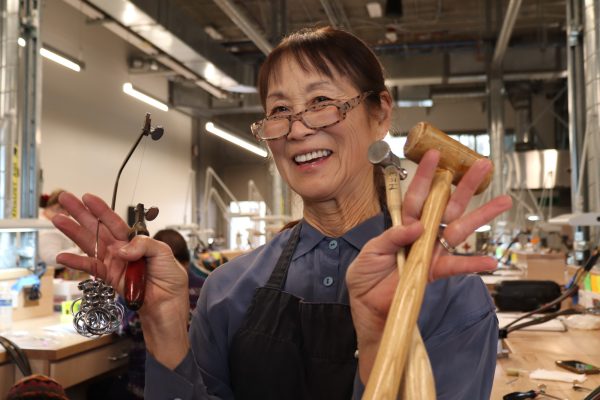
El Camino College is one of four community colleges in Southern California that offers a certificate of achievement in jewelry design and fabrication program.
Fifteen of 29 community colleges in Southern California do not offer jewelry making classes and the campuses that do include it as part of their studio arts program.
“I like that we have specialty programs that offer something a little different to our students,” Assistant Dean of Fine Arts Walter Cox said. “It’s a speciality within art that is not in a normal drawing, painting, sculpture subject area.”
As the first instructor, Oliver had set the precedent for how the jewelry studio should be designed and operated. The original studio, based out of Room 133 in the old Arts and Behavioral Science Building, was built with space for forging, hammering and casting metal.
Decades later, when the Fine Arts department moved to the new Arts Complex in 2023, steps were taken to make sure Oliver’s legacy would carry over to the new facilities and not be left behind with the now-deserted Arts and Behavioral Science Building.
The new tool room, a few paces from the main studio, carries the physical remnants of the old jewelry design studio and, to an extent, Oliver’s legacy. The steel anvils mounted on wooden stumps arranged in a quasi-semi circle in the center of the room go back as far back as the 1960s.
The move came just after in-person learning resumed at El Camino following the COVID-19 lockdown.
“We had to limit what what we were able to do,” Mori said about remote schooling as a jewelry instructor. Because of the restrictions found in vitrual learning, students had to make do with tool kits assembled by Mori and Christian-Kelly while working in limited spaces in their homes. Although the students found ways to work around these limitations, when the college asked who would like to return, Mori was one of the first to volunteer.
“I knew that I couldn’t do what needed to be done without a proper environment for the students,” Mori said.
The tool room doubles as a learning and a communal space where the beginner and intermediate classes work together on Friday afternoons.
One group huddles together around a hexagon-shaped table, chatting and laughing as they stamp imprints into teal, amethyst, ruby red and golden aluminum sheets. Another two sit at the anvils, earplugs and headphones in place to buffer the repetitive tapping as they hammer copper wire into graceful loops and curves.
One woman makes tiny indentations into a bangle-like confection of polished copper swirls and loops. She pauses, slipping it onto her wrist, twisting this way and that before taking it off her arm and hammering more improvements into the design.
“Isn’t it nice? They’re all doing stuff. They’re so focused,” Mori said, scanning the room with her hands on her hips, a wash-worn black apron tied around her waist, before checking to see how her students are doing in the next room.
That is where the main studio is located, an airy industrial space dominated by four long workbenches which could comfortably sit six people each and equipped with torches and overhead lamps to aid in more detailed work. Off-white roller blinds are cast half-way down the windows, muting the sunlight pouring in from the courtyard outside.
The room hums with chatter and soft jazz from the laptop Mori has set up at the front of the classroom. A quick glance at the screen shows a YouTube page for a video titled “NY Blues.”
In this industrial space of stainless steel fixtures, white walls and pale wooden cabinets, Mori is a splash of color.
Chunky blue glasses sit on top her head and a brightly patterned scarf sits wrapped loosely around her neck. Then there is the jewelry she wears.
A silver ring with a piece of polished agate as big as a knuckle sits comfortably on her middle finger. Mori likes to switch up her look with a rotating array of colorful earrings.
One week, it is a pair of lacy pink earrings resembling papel picado, a Mexican paper pennant.

Another week, it is a pair of marble-sized golden gyroscope.
This week is a pair of enameled fish with brightly patterned ribs. These were chosen in honor of the lesson of the week: enameling.
Mori goes from workbench to workbench, checking on the progress of her beginner and intermediate students. Helping her manage the mixed class is lab technician Kristina Christian-Kelly, a kind woman with frizzy blonde curls piled into a bun fanned out like a halo, who has worked at El Camino College for 15 years.
As she checks in on her students, Mori’s movements become more animated. She cracks wry smiles and lets out soft exclamations as she sees how much her students have progressed. She compliments a returning student, who is wearing a silver ring inlaid with a blue stone he had made the previous semester and offers input into the Coraline-inspired brooch design of a beginner in the class.
“Oh, you put it together,” Mori says when she sees her intermediate student Li Diaz holding a crown aloft.
Diaz, 36, is a welding major who has found a way to fuse their skills as a welder into jewelry design. Their creation has manifested into a steel circlet trimmed with bronze.
“It reminds me of Cersei at the end [of “Game of Thrones”] when she has short hair and is hating everyone,” Diaz said, twisting the crown this way and that in their hands. The simple circlet trimmed in bronze is more Stark-like but serves as a testament to their skill.
“You really can do anything, she’s so lenient,” Liam Messer said. He picks up a golden talon-like mechanism and slips it over his finger, flexing the claw-like appendage he has created. A studio arts major taking the intermediate Art 274 course, his inspiration comes from fantasy and tabletop games such as “Dungeons and Dragons.” His body of work turns out copper variants of “Magic the Gathering” cards, a dagger and silver rings inlaid with glass cabochons that resemble dragons’ eyes.
On the opposite side of the room, Alejandra Garcia, who returned to El Camino to get her certificate in jewelry design, sits hunched over her project, a metal file in one hand, as she carefully scrapes down the molten silver nubs holding her project together.
“It’s a lot of patience,” Garcia said before pausing, lifting the pendant and holding it up to the bright lamp light. “Teeny tiny, almost there.”
Then she gets back to filing down the nubs. Silver filigree scrollwork fills the empty space of the pendant’s frame, breathing life into the Hebrew “chai”-shaped outline. She pauses, then holds the pendant up to the light.
“I should have done it the opposite way, to clean it up, but…” she shrugged. “You live and you learn.”
The biggest challenge to the jewelry fabrication and design program isn’t adapting to a new studio space or fixing projects gone wrong. Instead, it is something currently unfolding outside of the classroom.
After June 2024, Mori will be retiring after almost 40 years of service to El Camino College.
“There is a tradition at El Camino College started by Richard Oliver and continued with me,” Mori said. “Hopefully, there will be enough support for the program’s continuation. We have a new facility and lots of tradition that needs teaching and nurturing.”
The new jewelry design and fabrication instructor has yet to be announced but Dean Cox is hopeful.

“My hopes would be, in a perfect world, finding a new full-time instructor. Someone fun with experience in contemporary practices,” Cox said.
Although still in its planning stages, there are talks with the ITECH department for a future collaboration in using computer-aided drafting 3D printing technology.
In the meantime, Mori is looking forward to what retirement will bring. There are so many countries she would like to visit: Ireland, India and Bhutan.
Then there are the hobbies she would like to get back into.
“I have so many projects,” Mori said. “I have a workshop at home that is nothing like this workshop. And so I want to get back there. You know, I have an [orchid] garden whose needs have been neglected. So I want to get back to that.”


